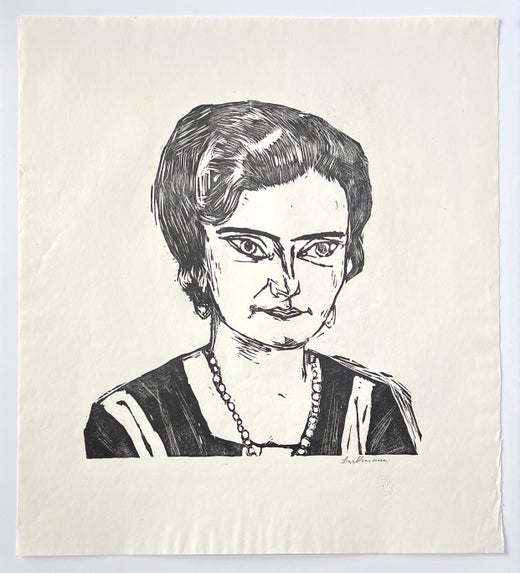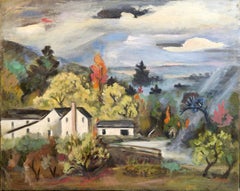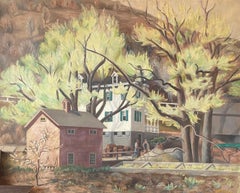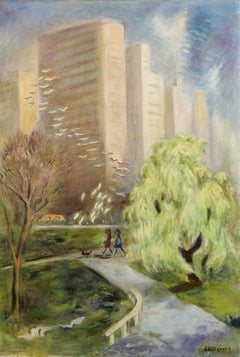Want more images or videos?
Request additional images or videos from the seller
1 of 9
Max Beckmann"Holzbrücke" Max Beckmann, 1922 Modernist Drypoint Urban Landscape1922
1922
$5,000List Price
About the Item
- Creator:Max Beckmann (1884-1950, German)
- Creation Year:1922
- Dimensions:Height: 15 in (38.1 cm)Width: 13 in (33.02 cm)
- More Editions & Sizes:Unique workPrice: $5,000
- Medium:
- Movement & Style:
- Period:
- Condition:
- Gallery Location:New York, NY
- Reference Number:1stDibs: LU1841215199442
Max Beckmann
Max Beckmann was one of the most influential artists of the 20th century - both as a painter and as an outstanding graphic artist. Printmaking was the main medium he worked in between 1914 and 1924, creating a total of 156 drypoints, 72 lithographs and 16 woodcuts. From wikipedia: Max Carl Friedrich Beckmann (February 12, 1884 – December 27, 1950) was a German painter, draftsman, printmaker, sculptor, and writer. Although he is classified as an Expressionist artist, he rejected both the term and the movement.[1] In the 1920s, he was associated with the New Objectivity (Neue Sachlichkeit), an outgrowth of Expressionism that opposed its introverted emotionalism. Even when dealing with light subject matter like circus performers, Beckmann often had an undercurrent of moodiness or unease in his works. By the 1930s, his work became more explicit in its horrifying imagery and distorted forms with combination of brutal realism and social criticism, coinciding with the rise of nazism in Germany.
About the Seller
5.0
Platinum Seller
Premium sellers with a 4.7+ rating and 24-hour response times
Established in 2022
1stDibs seller since 2022
122 sales on 1stDibs
Authenticity Guarantee
In the unlikely event there’s an issue with an item’s authenticity, contact us within 1 year for a full refund. DetailsMoney-Back Guarantee
If your item is not as described, is damaged in transit, or does not arrive, contact us within 7 days for a full refund. Details24-Hour Cancellation
You have a 24-hour grace period in which to reconsider your purchase, with no questions asked.Vetted Professional Sellers
Our world-class sellers must adhere to strict standards for service and quality, maintaining the integrity of our listings.Price-Match Guarantee
If you find that a seller listed the same item for a lower price elsewhere, we’ll match it.Trusted Global Delivery
Our best-in-class carrier network provides specialized shipping options worldwide, including custom delivery.You May Also Like
Chinese Ink painting-Landscape- The Last winter-summer No.2
Located in Beijing, CN
Contemporary emerging artist Min Ying was born in 1995. He is now a creation researcher of Sichuan Poetry and Calligraphy Painting Academy...
Category
2010s Modern Landscape Paintings
Materials
Ink, Handmade Paper
$1,500
Free Shipping
H 17.72 in W 26.78 in
Chinese Ink painting-Landscape- Distant Mountains No.1
Located in Beijing, CN
Contemporary emerging artist Min Ying was born in 1995. He is now a creation researcher of Sichuan Poetry and Calligraphy Painting Academy...
Category
2010s Modern Landscape Paintings
Materials
Ink, Handmade Paper
$1,500
Free Shipping
H 18.12 in W 13.39 in
Chinese Ink painting-Landscape- The Last winter-summer No.3
Located in Beijing, CN
Contemporary emerging artist Min Ying was born in 1995. He is now a creation researcher of Sichuan Poetry and Calligraphy Painting Academy...
Category
2010s Modern Landscape Paintings
Materials
Ink, Handmade Paper
$1,500
Free Shipping
H 17.72 in W 26.78 in
Chinese Ink painting-Landscape- Joy in the wilderness
Located in Beijing, CN
Contemporary emerging artist Min Ying was born in 1995. He is now a creation researcher of Sichuan Poetry and Calligraphy Painting Academy...
Category
2010s Modern Landscape Paintings
Materials
Ink, Handmade Paper
$1,500
Free Shipping
H 41.74 in W 19.3 in
'Any Day in America', Social Realist, Beat Generation, Allen Ginsberg
By Ron Croci
Located in Santa Cruz, CA
'Any Day in America' by Ron Croci.
Social Realist, Beat Generation, Allen Ginsberg
-----
Signed lower right, "Croci" for Ron Croci (American, born 1945), and painted circa 1970.
A ...
Category
1970s American Modern Figurative Paintings
Materials
Watercolor, Handmade Paper
$5,500
H 22.5 in W 30.5 in
French Contemporary Art by Sandra Detourbet - Le Temps
By Sandra Detourbet
Located in Paris, IDF
Ink on canvas & handmade paper
Sandra Detourbet is a French artist born in 1967 who works & lives in Ivry-sur-Seine, near Paris. She is graduated in ...
Category
2010s Abstract Expressionist Figurative Paintings
Materials
Ink, Canvas, Handmade Paper
$500
H 13.78 in W 10.83 in D 1.19 in
Figurative Watercolor paintin- Gong jianyu
Located in Beijing, CN
Gong Jianyu, (1990-), China,graduated from Jilin Normal University, graduated from the Department of Watercolor University of Northeast Normal University, and Professor Wang Huiyu. H...
Category
2010s Contemporary Figurative Paintings
Materials
Watercolor, Handmade Paper
Bites of Trivial Matter- Painting By Indian Artist in Red + Black on Paper
By Binay Sinha
Located in Gilroy, CA
"Bites of Trivial Matter," is a six panel work by Binay Sinha. The artist discusses modernity, specifically the effect in has on an urban society. The transition from small communi...
Category
2010s Contemporary Figurative Paintings
Materials
Acrylic, Watercolor, Handmade Paper
$4,195 Sale Price
34% Off
H 42 in W 54 in D 1 in
Bites of Trivial Matter-3rd Panel in 6 Piece Series by Indian Artist Binay Sinha
By Binay Sinha
Located in Gilroy, CA
"Bites of Trivial Matter," is a six panel work by Binay Sinha, but each piece is also available for sale individually. The artist discusses modernity, specifically the effect in has ...
Category
2010s Contemporary Figurative Paintings
Materials
Acrylic, Watercolor, Handmade Paper
$900 Sale Price
25% Off
H 20 in W 16 in D 0.5 in
Bites of Trivial Matter- Painting By Indian Artist in Red + Black on Paper (1/6)
By Binay Sinha
Located in Gilroy, CA
"Bites of Trivial Matter," is a six panel work by Binay Sinha, but each piece is also available for sale individually. The artist discusses modernity, specifically the effect in has ...
Category
2010s Contemporary Figurative Paintings
Materials
Acrylic, Watercolor, Handmade Paper
$900 Sale Price
25% Off
H 20 in W 16 in D 0.5 in
More From This Seller
View All"Newton’s Farm" Georgina Klitgaard, Modernist Hazy Autumn Landscape Painting
By Georgina Klitgaard
Located in New York, NY
Georgina Klitgaard
Newton’s Farm
Signed lower right
Oil on canvas
24 1/2 x 30 1/2 inches
Georgina Klitgaard’s art has sometimes gotten lost in the critical propensity to assign art...
Category
Early 20th Century American Modern Figurative Paintings
Materials
Canvas, Oil
"Johnny Walker’s Place" Georgina Klitgaard, 1929 American Modernist Landscape
By Georgina Klitgaard
Located in New York, NY
Georgina Klitgaard
Johnny Walker’s Place, circa 1929
Signed lower right
Oil on canvas
34 x 42 inches
Georgina Klitgaard’s art has sometimes gotten lost in the critical propensity t...
Category
1920s American Modern Figurative Paintings
Materials
Oil
"Central Park South" Georgina Klitgaard, Female Modernist New York Cityscape
By Georgina Klitgaard
Located in New York, NY
Georgina Klitgaard
Central Park South
Signed lower right
Oil on canvas
40 1/2 x 28 inches
Georgina Klitgaard’s art has sometimes gotten lost in the critical propensity to assign ar...
Category
Early 20th Century American Modern Landscape Paintings
Materials
Oil
"Pueblo Indians, Taos, New Mexico" Georgina Klitgaard, Modernist Figures
By Georgina Klitgaard
Located in New York, NY
Georgina Klitgaard
Pueblo Indians, Taos, New Mexico
Signed lower right
Oil on canvas
18 x 24 inches
Georgina Klitgaard’s art has sometimes gotten lost in the critical propensity to...
Category
Mid-20th Century American Modern Landscape Paintings
Materials
Canvas, Oil
"Spring Ploughing" Georgina Klitgaard, Modernist American Farmed Landscape
By Georgina Klitgaard
Located in New York, NY
Georgina Klitgaard
Spring Ploughing
Signed lower right
Oil on canvas
34 x 42 inches
Georgina Klitgaard’s art has sometimes gotten lost in the critical propensity to assign artists ...
Category
1940s American Modern Landscape Paintings
Materials
Canvas, Oil
"The Humber River" George Ennis, Intense Color American Modernist Landscape
Located in New York, NY
George Ennis
The Humber River
Signed lower left
Oil on canvas
20 x 24 inches
Ennis studied at Washington University in St. Louis and at the Chase School. He was a member of the Fed...
Category
Early 20th Century American Modern Landscape Paintings
Materials
Canvas, Oil
Recently Viewed
View AllMore Ways To Browse
Modern Art Urban Landscape
Antique Masquerade
1920 Modernist Painting
Max Beckmann Drypoint
Original Book Covers
Salzburg Festival
Street Urchin
Ted Hughes
The Guys With The Same Name
Theatre Canvas
Three Muses
Used Paint Robots
Used Tuba
Bill Withers
Car Racing Paintings
Children Playing On Beach
City Of Paris Painting
David Perry




